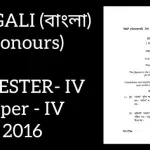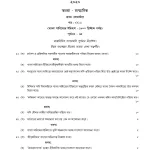Bengali Honours Question Paper 2016 covers a variety of topics and sections essential for students pursuing Bengali Honours. This guide provides detailed questions and answers, catering to the literary, historical, and analytical aspects of the subject. The solutions are straightforward, making them ideal for exam preparation and a deeper understanding of the syllabus.
Bengali Honours Literature Section
Question: What is the significance of Rabindranath Tagore in Bengali literature?
Answer: Rabindranath Tagore revolutionized Bengali literature with his poetry, prose, and songs. His works explore human emotions, nationalism, and spirituality.
Question: Discuss the major themes in Bankim Chandra Chattopadhyay’s novels.
Answer: Themes like nationalism, social reform, and romanticism are central to Bankim Chandra’s novels, reflecting the cultural ethos of Bengal during the colonial period.
Question: What role does Michael Madhusudan Dutta play in Bengali literature?
Answer: Michael Madhusudan Dutta is renowned for introducing blank verse and modern themes, blending Western influences with Bengali literary traditions.
Question: Analyze the portrayal of women in Sharatchandra Chattopadhyay’s works.
Answer: Sharatchandra’s works often depict women as strong and empathetic figures, challenging societal norms and advocating for gender equality.
Question: What is the importance of Bibhutibhushan Bandopadhyay’s ‘Pather Panchali’?
Answer: ‘Pather Panchali’ captures rural Bengal’s essence and human resilience, marking a milestone in Indian realist literature.
Question: How does Jibanananda Das redefine modern Bengali poetry?
Answer: Jibanananda Das introduces surreal imagery and explores existential themes, significantly impacting modern Bengali poetry.
Question: Explain the contribution of Kazi Nazrul Islam to Bengali poetry.
Answer: Known as the Rebel Poet, Kazi Nazrul Islam’s works address freedom, equality, and social justice, making him a symbol of resistance.
Question: Discuss the historical context of the Bengal Renaissance in literature.
Answer: The Bengal Renaissance saw a cultural awakening in Bengal, influencing literature through reformist ideas, Western education, and nationalist sentiments.
Question: What is the literary significance of the play ‘Nil Darpan’?
Answer: ‘Nil Darpan’ exposes the exploitation of Indian farmers under the British Indigo planters, highlighting early resistance to colonial oppression.
Question: How does Sukumar Ray contribute to Bengali children’s literature?
Answer: Sukumar Ray’s playful use of nonsense rhymes and satire in children’s literature remains unparalleled, blending humor with thought-provoking messages.
Question: Discuss the role of short stories in Bengali literature.
Answer: Bengali short stories capture societal nuances, human emotions, and moral dilemmas in a concise format, enriching literary traditions.
Question: What are the philosophical elements in Tagore’s ‘Gitanjali’?
Answer: ‘Gitanjali’ delves into themes like divine love, spirituality, and human existence, reflecting Tagore’s deep philosophical insights.
Question: How does Bengali literature address the Partition of Bengal?
Answer: Bengali literature portrays the trauma, displacement, and communal tensions caused by the Partition, highlighting its socio-political impact.
Question: Describe the evolution of Bengali poetry during the 19th century.
Answer: The 19th century saw Bengali poetry transition from traditional forms to modern expressions, influenced by Western literary movements.
Question: Analyze the use of symbolism in Jibanananda Das’s poetry.
Answer: Jibanananda Das uses symbols like nature and solitude to explore human emotions and existential themes, enriching Bengali poetry.
Question: What is the role of folklore in Bengali literature?
Answer: Folklore enriches Bengali literature by preserving cultural heritage, offering moral lessons, and inspiring creative narratives.
Question: Discuss the impact of Western literature on Bengali writings.
Answer: Western literature introduced new genres, styles, and themes, significantly influencing Bengali writers and expanding their creative horizons.
Question: Explain the significance of humor in Sukumar Ray’s works.
Answer: Humor in Sukumar Ray’s works engages readers while addressing social and ethical issues, making them timeless and relevant.
Question: What are the key characteristics of Bengali modernist literature?
Answer: Bengali modernist literature explores individualism, psychological depth, and existential dilemmas, marking a shift from traditional narratives.
Bengali Honours Historical Section
Question: What is the historical context of the Bengal Renaissance?
Answer: The Bengal Renaissance was a cultural and intellectual awakening during the 19th century, driven by figures like Raja Rammohan Roy and Ishwar Chandra Vidyasagar.
Question: Discuss the role of Rabindranath Tagore in the Indian freedom movement.
Answer: Tagore supported the Swadeshi Movement and critiqued British policies through his works, promoting self-reliance and cultural pride.
Question: How did colonial rule influence Bengali literature?
Answer: Colonial rule introduced Western education and ideologies, inspiring new literary forms and themes addressing resistance and reform.
Question: What is the significance of the Satyagraha movement in Bengal?
Answer: The Satyagraha movement united Bengalis in nonviolent resistance against British oppression, influencing contemporary literature and arts.
Question: Analyze the impact of the Partition of Bengal in 1905 on Bengali society.
Answer: The 1905 Partition spurred nationalist movements, intensified communal tensions, and deeply affected Bengali literature and identity.
Question: What role did Bengali writers play in shaping Indian nationalism?
Answer: Bengali writers like Bankim Chandra and Tagore inspired nationalism through their works, emphasizing cultural unity and resistance to oppression.
Question: Describe the significance of the Swadeshi movement in Bengal.
Answer: The Swadeshi movement encouraged the use of indigenous goods, fostering economic independence and cultural pride among Bengalis.
Question: What was the influence of Ishwar Chandra Vidyasagar on Bengali society?
Answer: Ishwar Chandra Vidyasagar advocated for women’s education, widow remarriage, and social reform, profoundly impacting Bengali society.
Question: Explain the cultural impact of the Indigo Revolt on Bengali literature.
Answer: The Indigo Revolt inspired works like ‘Nil Darpan,’ highlighting farmer exploitation and advocating for social justice.
Question: How did the 1947 Partition shape modern Bengali literature?
Answer: The 1947 Partition led to themes of displacement, loss, and identity in modern Bengali literature, reflecting its profound impact.
Question: Discuss the role of women in the Bengal Renaissance.
Answer: Women like Rokeya Sakhawat Hossain emerged as reformers and writers, advocating for gender equality during the Bengal Renaissance.
Question: What is the significance of the Aligarh Movement in Bengal?
Answer: Though primarily Islamic, the Aligarh Movement influenced Bengal by promoting modern education and communal harmony.
Question: Describe the role of the Indian National Congress in Bengal’s history.
Answer: The Indian National Congress organized resistance against British policies, with Bengal playing a central role in nationalist movements.
Question: How did the Quit India Movement affect Bengal?
Answer: The Quit India Movement mobilized Bengalis across classes, intensifying anti-colonial protests and inspiring revolutionary literature.
Question: Discuss the importance of journalism during colonial Bengal.
Answer: Journalism in colonial Bengal informed and united people, with newspapers like ‘Amrita Bazar Patrika’ advocating for freedom and reform.
Question: Explain the cultural significance of Durga Puja in Bengal.
Answer: Durga Puja is a celebration of art, devotion, and community spirit, reflecting Bengal’s rich cultural and religious heritage.
Question: What was the impact of the Industrial Revolution on Bengal?
Answer: The Industrial Revolution brought economic changes to Bengal, fostering urbanization while also causing social upheavals.
Question: How did Bengali theatre evolve during the colonial period?
Answer: Bengali theatre addressed social issues and resistance, becoming a platform for cultural expression and reform during colonial times.
Question: Discuss the significance of folk music in Bengali culture.
Answer: Folk music preserves Bengal’s rural traditions, conveying themes of love, nature, and spirituality, enriching cultural identity.
Bengali Honours Analytical Section
Question: How does the use of language in Bengali poetry differ from prose?
Answer: Bengali poetry uses lyrical and rhythmic language, while prose focuses on narrative clarity and detailed descriptions.
Question: What are the characteristics of a good literary translation?
Answer: A good translation maintains the original text’s essence, cultural nuances, and emotional impact.
Question: How does setting influence Bengali novels?
Answer: Settings in Bengali novels often reflect societal realities, enhancing the narrative’s depth and authenticity.
Question: What is the role of metaphors in Bengali literature?
Answer: Metaphors enrich Bengali literature by offering deeper meanings and enhancing the emotional impact of the narrative.
Question: Discuss the significance of autobiographical elements in Tagore’s works.
Answer: Tagore’s works often include personal experiences and reflections, making them relatable and profound.
Question: How does Bengali literature address social inequality?
Answer: Bengali literature critiques social inequality through characters and stories that challenge discrimination and advocate
Latest Posts
- Step-by-step guide to download and apply for jee mains admit card 202
- Comprehensive 2025 government holidays and recruitment details for job seekers
- JEE Mains Admit Card 2025: Your Step-by-Step Guide to Downloading the Hall Ticket
- Everything You Need to Know About 2025 Government Holidays Recruitment
- Comprehensive Guide to rrb d group recruitment 2025 – Eligibility, Vacancies, and Application
- Detailed guide to nps trust recruitment 2025 vacancies, eligibility and apply process
- Comprehensive guide to hpcl recruitment 2025 notification, vacancies, and application process
- ignou bed admission 2025 complete recruitment guide with eligibility and process
- Comprehensive Guide to Indian Army Agniveer Recruitment 2025 Notification and Jobs
- Everything You Must Know About CBSE Board Exams 2025 Changes & New Rules





